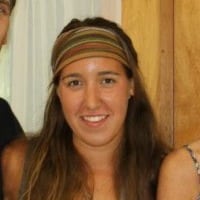I have been writing these WeRunFar columns for a few years now and I have always admired the love and dedication some runners have for one race course or another. Chrissy Ferguson is no different. She found her niche in the sport of ultrarunning, falling in love with the Arkansas Traveller 100 Mile (AT100) and the community that surrounds it.
Okay, so when I say that many ultrarunners have a dedication to and love of a particular race course, I may also be describing a bit of obsession. Chrissy is no different. Her bond with the AT100 began in the 1990s with her first run there. Since then, her relationship with the race has continued to grow. It’s led her to a marriage with fellow AT100 lover Stan Ferguson, to accumulating 19 AT100 finishes so far, and to co-race directing the AT100 for 16 years.
And, it was pretty much love at first sight.
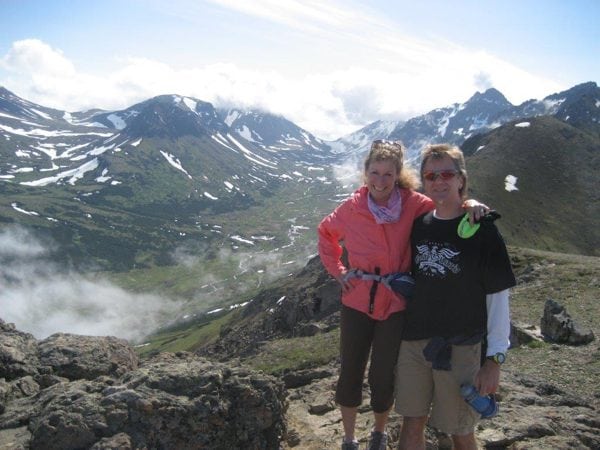
Chrissy and Stan Ferguson atop Flattop Mountain in Alaska in 2003. All photos courtesy of Chrissy, Stan, and friends unless otherwise noted.
The young Chrissy Ferguson and her family relocated often, on the account of her father’s job with the U.S. Air Force. When she was five, he settled the family down in Arizona and got a job in the semi-conductor business, the same business Chrissy first entered into after finishing her schooling. From age 18 through her mid-thirties, it seems like Chrissy’s life was on a path of near-continuous significant transformation.
“I was 18 and still eating everything in sight so I kind of chunked out,” she said, after being a diver in high school. “And I smoked! Can you believe that? Oh my gosh…” It was then, when she met the man who was to be her first husband, a semi-professional tennis player. His tennis-focused lifestyle kicked her butt back into shape and she quit smoking and began to play competitive tennis. By then, the two had moved to and settled in Northern California.
In 1984, a friend told Chrissy about her goal of running a marathon, and of course, Chrissy jumped at the chance. “So, I trained for three weeks and ran a marathon,” she said, guessing her time was around four hours. “I could barely freakin’ move after.”
Over the next few years, her life kept changing. She decided it was time to “do what she wanted to do.” She quit her job and started getting into shape to pass the physical-agility test to become a firefighter, a very male-dominant career back then. She continued her running and trained for the same marathon one year later, finishing an hour faster in 3:10. She was also still “kicking butt” on the tennis court, lifting weights, and swinging an ax around. She did basically anything and everything she could in order to pass that test. “To be a firefighter you have to run one-and-a-half miles under 12 minutes, so under an eight-minute mile,” she said. “I was able to pass the physical agility, and then the comprehension and psych tests in the academy.”
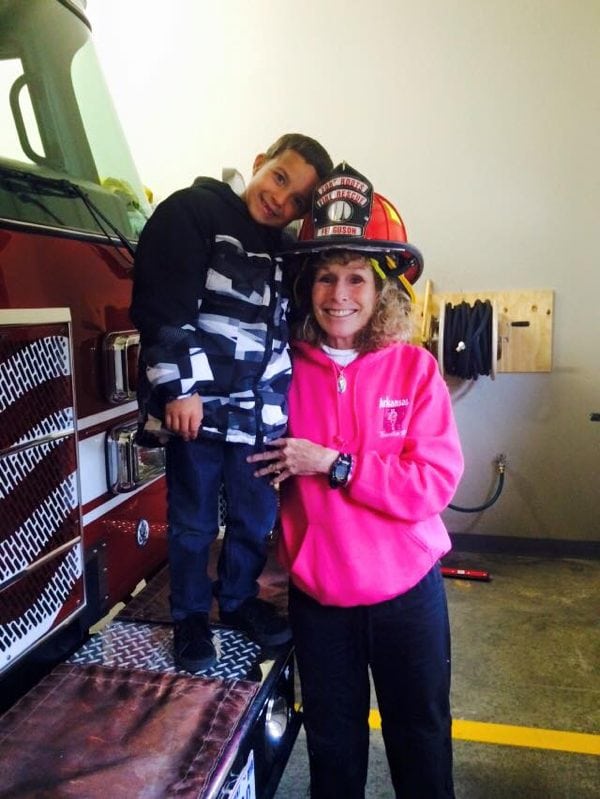
Chrissy at the fire station with her grandson Hunter.
Her competitiveness continued to grow and Chrissy realized her 3:10 marathon time was not so far off the then Olympic Marathon Trials qualifying time for women, 2:50, thus initiating her next goal.
The birth of her child, her daughter Elizabeth, and a divorce from her first husband produced more transformation in Chrissy’s life. “My first husband and I split up and I have not picked up a tennis racket since. I just started running,” she said, “and I have not quit.” The next marathon, after her daughter’s birth, was just under three hours. Chrissy was still ready to work toward that qualifying time, but another change began to creep up on her. As she was training on the roads, a boss at her job talked to her about his own training for some 100 miler called the Western States 100.
“He said [that to qualify,] you have to run 50 miles under 11 hours. I thought, Well, I can run a 50 miler in under 11 hours,” she remembered. “So, I decided I was going to train and run this 50 miler under 11 hours and I ran it in 7:36, I believe, and I was third female. Then, I had the bug and wanted to run Western States.”
Following that, Chrissy called the race director of an upcoming 50 miler, which at the time offered automatic Western States entry to its winners, to ask for entry into his race because she wanted to run it, win it, and qualify for Western States. “He laughed at me because everyone calls and says, ‘Hey, I want to run your race and win and get into Western States,” she said. “But I did it.” She went on to finish her first Western States in 1992.
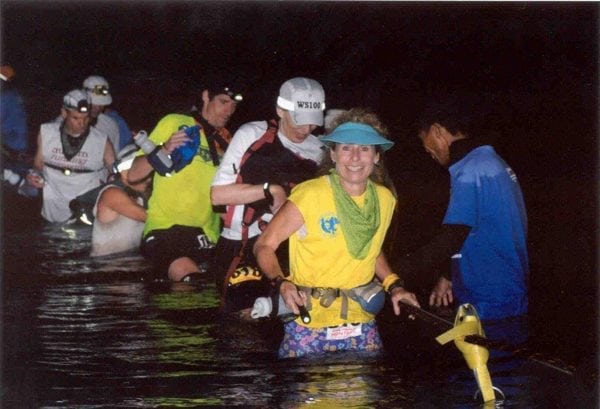
Chrissy at the Rucky Chucky River Crossing at Western States during her bid at the 2009 Grand Slam of Ultrarunning.
“I was hooked,” she described. “For the next four to five years, I didn’t run anything under a 50k. I only ran ultras.” Chrissy found she is like that pink Energizer Bunny, able to go and go and go, and not only keep going, but able to maintain or even increase her speed. Plus, she found the trail and ultra world more laid back than the road-running atmosphere. “It wasn’t about beating people. It was about running, having fun, and being out there all day,” she said. “Finishing was winning. It didn’t matter what your time was. If you finished the 100 miles, then, ‘Dude, you won!’”
So, where were we? It was the second half of 1992. Chrissy was living in Northern California and had a couple ultra finishes, including one at Western States, and she wanted to run it again. At the time, only the top-five women and top-10 men were guaranteed entries into the next year’s race, so with Chrissy’s 11th-place finish in her first try at the event, she had to re-qualify somewhere else.
“A friend said, ‘Hey, there is this new race in Arkansas. My good friends Lou and Charley Peyton are the race directors and you need to go run that and win that so you will be a guarantee in Western States,’” she said. “I ran it and I loved it.” Her friend was, of course, referring to the AT100. The AT100 starts in Ouachita National Forest in Williams Junction, about 30 miles west of Little Rock. It instantly became Chrissy’s beloved route.
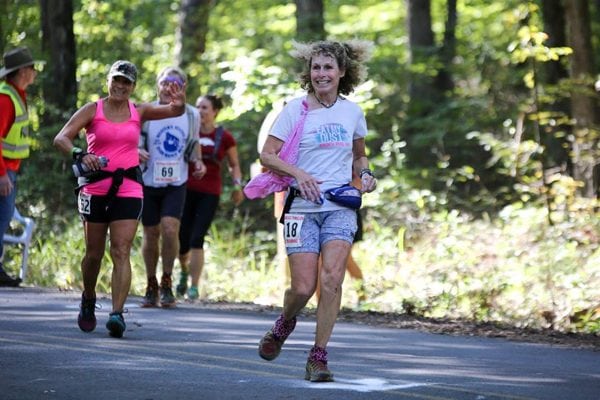
Chrissy running the 2016 AT100. Photo: Sheldon Smith
Chrissy came to the race with the expectation to win it just for Western Sates, but little did she know she was starting a long, deep relationship with the volunteers, fellow runners, some guy named Stan, and the southern ultra community that she would soon call home.
“The people are so nice. I remember the first time I ran it, I came here and they called me ‘Miss Chrissy,’” she said. “I thought, Gosh, that’s Southern hospitality. No one has ever called me ‘Miss Chrissy.’ I have been called many things, but that was not one of them!”
In 1995, she returned for another go-around and a few weeks before the race, her pacer tore a calf muscle and had to drop from his duties, but he guaranteed he would find her a good replacement. “He ended up finding my husband, Stan Ferguson,” she said. “He paced me the last 32 miles and by the end of the race I knew I was going to marry him.”

Chrissy and Stan celebrating their 20th wedding anniversary with a vow renewal.
Before the race, the two talked on the phone, but it was strictly race business. “I provided everything. I wasn’t leaving anything up to chance,” she said. “He had the flashlights I wanted him to have. I told him to have the pack ready to go and just be at the aid stations when I tell you to be there. I told him, ‘When I come, I will tell you what I need and you get it for me. I am going to be in and out of the aid station and then you can catch up to me.’”
The first priority was winning the race, but the second thought that popped in her mind was, “He’s kinda’ cute. He was kind of a throwback from the ’80s. He had the long hair with the mullet at the top,” she said. “He was good looking, but oh gosh, the hair had to go.”
For Stan, the first priority was to get Chrissy to the finish line before everyone else, no matter what. This is Stan’s version of that same story: “Chrissy and I first met in 1995 when someone arranged for me to pace her at the AT100 that year, but I had remembered seeing her the year before, when I was helping at an aid station. Some people come in and go out pretty quietly. But whether it’s 1994 or 2017, Chrissy never sneaks into an aid station,” he explained. “If she’s not heard even before she gets there, then it’s certain that everyone is fully aware when she’s ‘in the house.’ These days, it may be more likely that she’s barking out instructions for something in particular that is needed by one of the people she’s taken under her wing over the previous few miles. When she was more competitive, it would be calling out for whatever she needed in order to get in and out quickly. Always positive and appreciative, but definitely not inconspicuous.”
Back to Chrissy’s side of things. “At the end of the race, I was like, ‘Go out to dinner with me tomorrow. I want to repay you for pacing me,’” she told him. “When really, it wasn’t for pacing me, I just wanted to go out to dinner with him!” She kissed him on the cheek that night and gave him two numbers: hers back in California and her mother’s, who Chrissy was heading to visit after the race.
“He called me at my mom’s house, and I knew then that we would get married,” she said. The two were married the night of the AT100 in 1996, during the pre-race meeting held at Camp Ouachita near Lake Sylvia. The honeymoon trip included Chrissy running the race the next morning with Stan pacing her. They moved to California for a year and a half while Chrissy looked for a firefighting job. In 1997, the pair ran and finished the AT100 together. In 1998, they moved back to Arkansas, settling in the town of Maumelle, near Little Rock.
“One thing that’s kind of unique about our original ceremony is that it was part of the pre-race festivities for the AT100, which was one of only about a dozen 100-mile events in the country at that time,” Stan said. “Several times over the years I’ve been at a race somewhere in the USA and had someone I didn’t know introduce themselves and tell me that they were at my wedding.”
Stan is as much in love with the AT100 as Chrissy is, and was all in when Chrissy wanted to take over the race after the original race directors wanted to retire in 2000.
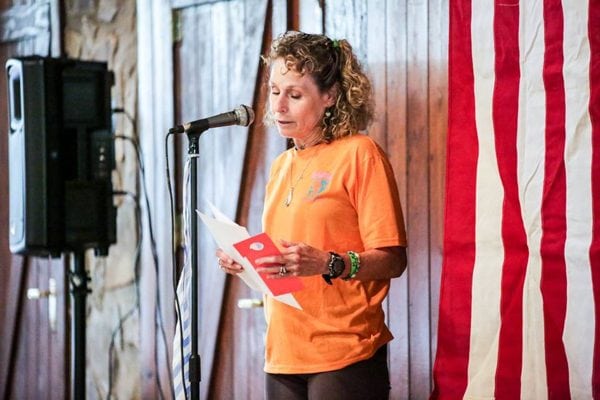
Chrissy giving the pre-race “Don’t be a Dumbass” speech before the 2016 AT100.
“I only had eight finishes, so I needed two more finishes to get my 10,” she exclaimed. “I wanted my 10 finishes. I told Stan we have to take the race over because I want 10 finishes.”
2001 was their first go at directing. They have not changed the course one step, and have got the directing down perfect for splitting up the duties. They also direct an April race, the Ouachita 50k/50 Mile, one of the races in the Arkansas Ultra Running Association.
Chrissy takes charge of the prepping of the AT100, getting aid stations, volunteers, and pre-race details taken care of so that come race day, she can enjoy the day and run the race while Stan becomes the main RD. Then, vice versa, for Ouachita. Chrissy takes over race-director duties for the day while Stan takes to the trails.

Stan and Chrissy hugging at the finish of the 2009 Grand Slam of Ultrarunning.
The AT100 is a mixture of forest roads and amazing volunteers, two traits that Chrissy instantly loved about the race. “The best part of the race is that every aid station is put on by runners. They all want to make sure you finish. They are runners so they get satisfaction in knowing that you cross the finish line,” she said. “A lot of my aid-station people will actually close up the aid station and go together to the finish line and say, ‘Oh yeah! I remember her! She looked great when she came through the station.’”
The race limit is set at a total of 165 runners, guaranteeing the race directors and volunteers can account for every runner at every moment. There are about 450 volunteers, making it a three-to-one ratio, Chrissy added.
“The other thing I love is there’s less than three miles of road and when I say road, I mean asphalt,” she described. “There are different levels of forest road. There are some rutted out so bad you have to watch every step you take.”
Chrissy and Stan are pretty much in sync with everything they do, especially when it comes to their own running plans. They run together as much as possible, and back when they were younger and doing more competitive racing, they both were running high-mileage weeks of up to 120 miles.
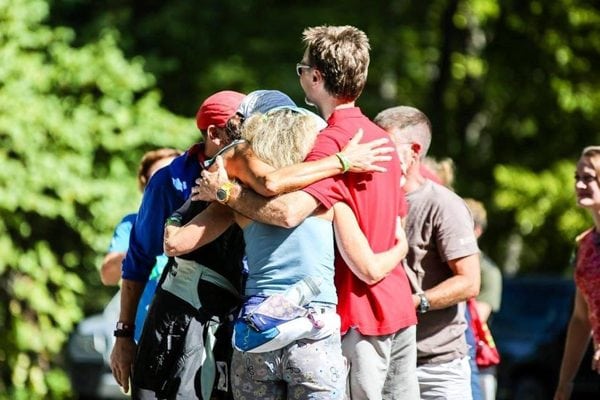
Celebrating at the 19th AT100.
Chrissy works as the captain of the federally funded fire department in Maumelle, Arkansas. She works 24 hours on and 24 hours off and has designated Fridays and Saturdays off every weekend, permitting many weekends open for her races. When she began at the station, she was the only female. There were some issues back then when it came to women within the department, she said. Now, she is the oldest firefighter in the station, overseeing a group of men and a few women. Her crew has grown to accept her bossy nature, but still sees her two-a-day workouts as a bit crazy.
When she was in intense training, Chrissy would grab her radio and run quarter-mile loops around the station, getting in about six to eight miles. She would do that twice a day if she was on her 24-hours-on schedule. On her 24 hours off, she still ran doubles of six to eight miles each, in addition to lifting weights and doing Stairmaster and rowing workouts. On the weekends, she and Stan would do back-to-back long runs of 25 to 30 miles a day.
In 2009, the two did the Grand Slam of Ultrarunning together, the only couple to have done it the same year, Chrissy said proudly.
When they are in season, Chrissy runs and Stan is the head pacer and crew member, then vice versa. When he has a big race planned, she joins him for support. “It’s hard to imagine Chrissy and me not having some kind of running lifestyle as long as we’re able,” Stan said. “We don’t actually run together nearly as much any more, but we do a lot of the same things. Even if we embark on different adventures, I think we always understand the motivation of why one of us wants to do whatever it is.”
Even in times of “unpleasantness,” it is nice to have someone who understands the pain and the determination of an ultra, he added.
“One of the more memorable moments we had, and one that is often recounted when we tell running stories, was from a 50-mile race when I was pacing her about a year after we were married,” he began. “She was in first place among the women, and about halfway up a three-mile climb at the very end of the race. I looked back and noticed that the second-place woman appeared to have gained some ground. I told Chrissy, ‘Baby, I think you may need to run a little faster.’ She was working the hill pretty hard, but not so hard to keep her from yelling back, ‘Shut the f— up! I’m running as fast as I can!’ To this day, we enjoy telling that story, and still argue about how close the other girl actually was.”
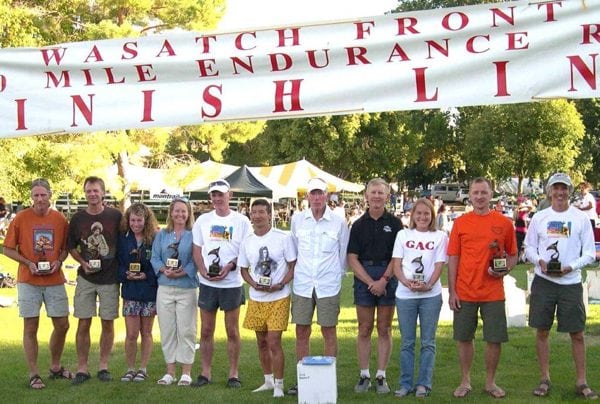
The 2009 Grand Slam finishers. Stan and Chrissy are second and third from the left, respectively.
She traveled the world competing in what’s now called the IAU 100k World Championships in the mid-to-late ’90s, running in Japan and Holland. Now she’s undertaking a 50-state running project of running a marathon or more in every state. The final three races are planned for this year: one each in Connecticut, New Hampshire, and Maryland. This is in addition to the 10 or so other races she has planned for the year.
“I am doing Tunnel Hill 50 Mile in November,” she said. “At the beginning of the year, I say, ‘I think I am going to do this and this and this.’ I average around 10 to 12 marathons and beyond plus all the 5ks and 10ks we do.” She also has the Strolling Jim 40 Mile Run, one she’s done many times but not for several years now, and the Burning River 50 Mile, a new one for her, picked out for the season.
The big race this year will be her 20th AT100, which may be her last 100 miler. “My right arch is completely collapsed,” she said. “My foot doctor told me my 100-mile days are limited, so pick them wisely.” This year at the AT100, nothing will stop her. Stan will be running with her since it will be 20 years since Stan and Chrissy’s first AT100 that they finished together.
Also, this will be the first year the two are no longer the race directors of the AT100, an announcement they recently made. They passed the 29th annual race onto Thomas Chapin and given up their other RDing duties.
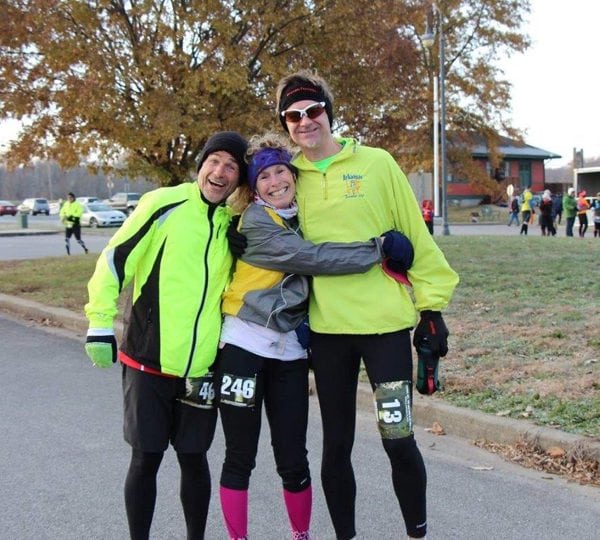
At the start of the Tunnel Hill 50 Mile in 2013.
“We are slowly stepping down, handing off the races to other people,” she said. “I am retiring from the fire service next year and 16 years is a long time to be a race director.” Despite her favorite part about being a RD and fire captain–having the ability to boss people around–she has accepted that the new age of runners and races just do not have that same old-school personality by which she lives.
“My patience is starting wear a bit thin. When people ask me stupid questions, there comes a point you can’t just blow it off anymore and you want to put your hands through the phone and ring their neck,” she said, laughing. According to Chrissy, the younger generation of runners needs a little more handholding… to put it in nice terms. “It used to be that when you went to the starting line of a 100 miler, you knew you had to be prepared and you had to have what clothing you needed, how many bottles you needed, you read your instructions, you knew what kind of markings they had, and you had the map in your pack,” she listed. “People don’t do that anymore! They want you to hold their hand the whole race.” Thus, Chrissy and Stan are relinquishing their control and letting new blood and fresh, patient ears take over the races.
Stan and Chrissy are planning on splitting their retired life in Arkansas for half the year and in Northern California near where Chrissy’s daughter and grandson, Hunter, live for the other half. Plus, she will be closer to the Western States Trail, she excitedly pointed out.

Elizabeth, Hunter, and Chrissy at the California International Marathon in 2013.
When Chrissy does something, whether it is to train for a race, to pass a firefighter test, or to direct a race, she goes all in with every fiber of her body. Even with her jewelry-making and arts-and-crafts hobbies, activities meant to relax her after a long run or 24-hour shift at the station, her commitment and passion is as strong as the metal wiring used for a necklace. Above her garage sits Chrissy’s craft space, equipped with a ceramic and glass jewelry kiln. From her work, the top finishers of the Ouachita ultras received homemade awards. There is no stopping this woman. What she does, she succeeds at and leads the way in doing.
“She is fun and she’s tough, although she typically doesn’t like being labeled as tough,” Stan said. “She works hard, and doesn’t like doing things halfway. She expects the same of others. As long as you do what she says, no one gets hurt. We joke about that a lot.”
“This year I am doing my 20th AT100,” she said. There will be no stopping this woman. It might take, she says, a lot of duct tape.
“My goal now is to be able to run when I am 80,” she added. “Yeah, I may be able to run hard and get one more good year in. But I may end up decapitating myself because I pushed my body so hard. Now I just listen to my body and run. And you know what? When I am 80 years old and running, guess what? I’ll be winning my age group again!”
Call for Comments (from Meghan)
- Have you run or raced with Chrissy? Can you share a story from doing so?
- How about running one of the events she has directed? Do you have a story from it?

Chrissy and Stan vacationing in Hawaii in 2011.
